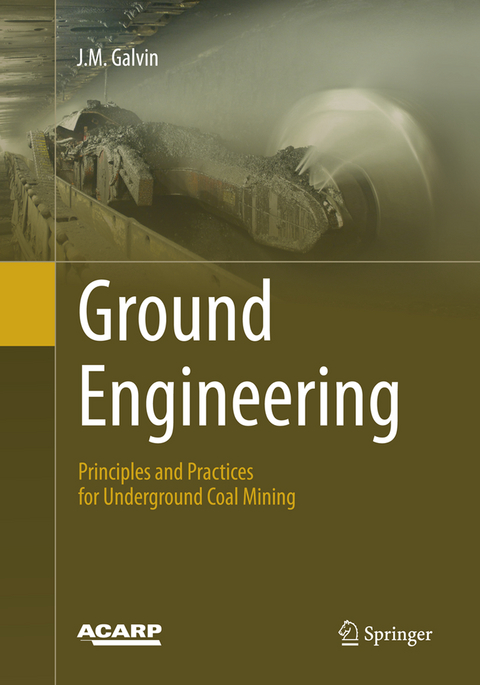
Ground Engineering - Principles and Practices for Underground Coal Mining
Springer International Publishing (Verlag)
978-3-319-79719-9 (ISBN)
This book teaches readers ground engineering principles and related mining and risk management practices associated with underground coal mining. It establishes the basic elements of risk management and the fundamental principles of ground behaviour and then applies these to the essential building blocks of any underground coal mining system, comprising excavations, pillars, and interactions between workings.
Readers will also learn about types of ground support and reinforcement systems and their operating mechanisms. These elements provide the platform whereby the principles can be applied to mining practice and risk management, directed primarily to bord and pillar mining, pillar extraction, longwall mining, sub-surface and surface subsidence, and operational hazards.
The text concludes by presenting the framework of risk-based ground control management systems for achieving safe workplaces and efficient mining operations. In addition, a comprehensive reference list provides additional sources of information on the subject. Throughout, a large variety of examples show good and bad mining situations in order to demonstrate the application, or absence, of the established principles in practice.Written by an expert in underground coal mining and risk management, this book will help students and practitioners gain a deep understanding of the basic principles behind designing and conducting mining operations that are safe, efficient, and economically viable.
About the author
Emeritus Professor Jim Galvin has a relatively unique combination of industrial, research and academic experience in the mining industry that spans specialist research and applied knowledge in ground engineering, mine management and risk management. His career encompasses directing ground engineering research groups in South Africa and Australia; practical mining experience, including active participation in the mines rescue service and responsibility for the design, operation, and management of large underground coal mines and for the consequences of loss of ground control as a mine manager; appointments as Professor and Head of the School of Mining Engineering at the University of New South Wales; and safety advisor to a number of Boards of Directors of organisations associated with mining.Awards
Winner of the ACARP Excellence Research Award 2016.
The Australian Coal Industry's Research Program selects recipients to receive ACARP Research and Industry Excellence Awards every two years. The recipients are selected on the recommendation of technical committees. They are honored for achievement of a considerable advance in an area of importance to the Australian coal mining industry. An important criterion is the likelihood of the results from the project being applied in mines.Winner of the Merv Harris Award from the Mine Managers Association of Australia.
The Merv Harris Award is named for Merv Harris who donated money to be invested for a continuing award in 1988. With the award, the Mine Managers Association of Australia honors members of the Association who demonstrate technical achievement in the Australian Coal Mining Industry. The first award was granted in 1990, since then, only two people have received this honor.The book has received the following awards.... AGS (Australian Geomechanics Society) congratulates Dr Galvin for these awards
Emeritus Professor Jim Galvin has a relatively unique combination of industrial, research and academic experience in the mining industry that spans specialist research and applied knowledge in ground engineering, mine management and risk management. His career encompasses directing ground engineering research groups in South Africa and Australia; practical mining experience, including active participation in the mines rescue service and responsibility for the design, operation, and management of large underground coal mines and for the consequences of loss of ground control as a mine manager; appointments as Professor and Head of the School of Mining Engineering at the University of New South Wales; and safety advisor to a number of Boards of Directors of organisations associated with mining.
1. Scope of ground engineering.- 2. Fundamental principles for ground engineering.- 3. Excavation mechanics.- 4. Pillar systems.- 5. Interaction between workings.- 6. Support and reinforcement.- Systems.- 7. Ground support design.- 8. Pillar extraction.- 9. Longwall mining.- 10. Overburden subsidence.- 11. Operational hazards.- 12. Managing risk in ground engineering.- Glossary of terms and symbols.- Appendices.
lt;p>"Each of the 12 chapters begins with an abstract and a list of keywords, and ends with a reference list. ... The book is splendidly illustrated with presentations of quantitative data, mine plans and photographs of some of the untoward things that can happen in underground mines. ... Ground engineering should attract international sales and help mine operators to achieve optimum mining efficiency without compromising safety." (Professor Ian Rae, ATSE Focus, Issue 199, December, 2016)
"To the knowledge of the reviewer there is no comparable text that covers ground engineering principles and underground coal mining practice in such a comprehensive way. This book fills a serious gap in the mining and rock mechanics literature. ... This book is not only of value to ground engineering specialists on coal mines, but will be of equal value to coal mine planning personnel, coal mine managers, and mining authorities." (Horst Wagner, The Journal of the Southern African Institute of Mining and Metallurgy, November, 2016)"The book provides a very logical and complete approach to all of the major ground engineering challenges facing modern underground coal mines ... . I have no doubt that this book has filled a major void in the field, not just in Australia, but also internationally. ... it will rapidly become a 'must-have' reference book, not just for students and researchers, but as a life-long reference point for career professionals working in the underground coal sectors around the world." (Bruce Hebblewhite, Bulletin Magazine, August, 2016)
"The book provides an outstanding, detailed and much needed, account of ground engineering principles and their application in underground coal mining practice in Australia and internationally. ... I recommend this book unreservedly to all those having responsibility for identifying and managing ground control-related risk issues in underground coal mines, including mine managers, planners, operators, geotechnical engineers (including consultants), mining regulators, academics and especially mining engineering students." (Edwin T. Brown, Australian Geomechanics, Vol. 51 (1), March, 2016)
| Erscheint lt. Verlag | 31.3.2018 |
|---|---|
| Zusatzinfo | XXIII, 684 p. 421 illus., 285 illus. in color. |
| Verlagsort | Cham |
| Sprache | englisch |
| Maße | 178 x 254 mm |
| Gewicht | 1802 g |
| Themenwelt | Naturwissenschaften ► Geowissenschaften ► Meteorologie / Klimatologie |
| Technik ► Bauwesen | |
| Schlagworte | Geotechnical Risk Management • Ground control • Ground engineering • Ground Support and Reinforcement • Mineral Resources • Underground Coal Mining |
| ISBN-10 | 3-319-79719-0 / 3319797190 |
| ISBN-13 | 978-3-319-79719-9 / 9783319797199 |
| Zustand | Neuware |
| Haben Sie eine Frage zum Produkt? |
aus dem Bereich


